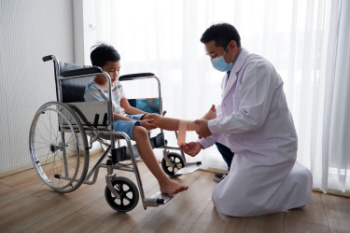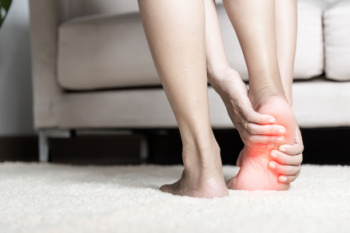
Congenital foot abnormalities are structural issues present at birth, such as clubfoot, flat feet, or extra toes. These conditions can affect how a child walks, stands, or develops overall balance. Some are noticed right away, while others become more obvious as a child begins to walk. Treatment depends on the type and severity of the condition. In many cases, gentle stretching, bracing, or special shoes are used early in life to guide proper foot growth. More complex cases may require surgery to correct bone or joint alignment and are referred to a surgeon. Early diagnosis and treatment are important, as they can help prevent long-term mobility or pain issues. With the right care, most children go on to move and play without problems. If you notice unusual shape or movement in your child’s feet, it is suggested that you see a chiropodist for a diagnosis and appropriate treatment.
If your child is experiencing foot or ankle pain, please consult with one of the chiropodists from Complete Family Footcare & Therapy. Our clinicians will assess your condition and provide you with quality foot and ankle treatment.
Common Causes of Foot Pain in Children
While children can experience many of the same foot problems as adults do, some foot problems may be more common during childhood.
Causes of foot pain in children can include:
-
Deformities that are present from birth, such as flat feet or clubfoot
-
Sever’s disease, which is an inflammation of the growth plate in the heel bone
-
Various sports injuries, such as sprains and fractures
-
Ingrown toenails
-
Athlete’s foot
-
Plantar warts
Prevention
It is important to look after the health of children’s feet in order to prevent future problems from arising. Keep your child’s feet clean and dry, trim their toenails regularly, ensure their shoes fit properly, and keep a watchful eye on any symptoms of foot pain, such as limping. If you notice any symptoms or if your child complains of foot pain, a chiropodist can help.
If you have any questions, please feel free to contact our offices located in . We offer the newest diagnostic and treatment technologies for all your foot care needs.

As the warmer months approach, it is important to give your feet the care they need to stay healthy and comfortable. Regular cleaning helps remove dirt and bacteria, keeping the skin fresh and free from infections. Moisturizing daily prevents dryness and cracking, ensuring soft and smooth skin. A pedicure can improve the appearance of the nails while also maintaining proper hygiene by trimming and shaping them correctly. Choosing the right footwear is essential for both comfort and support. Sandals and open-toed shoes should provide proper arch support and cushioning to prevent foot strain. Paying attention to foot care during seasonal transitions can enhance overall comfort and health. If you have foot pain, it is suggested that you consult a chiropodist who can treat various foot conditions, and offer you tips on seasonal foot care.
Fall is a time of increased outdoor activities, sports, and back-to-school events. It can also be a time of increased foot and ankle problems. For all of your autumn foot care needs, please consult with one of the chiropodists from Complete Family Footcare & Therapy. Our clinicians can help you maintain the health of your lower limbs and your mobility.
Common foot and ankle problems that can arise during the fall season include:
-
Bunions - Bony growths on the outsides of the big toe joints
-
Hammertoes - Toe deformity that causes the toe to bend downward at the middle joint
-
Plantar fasciitis - Inflammation of the ligament that runs along the bottom of the foot
-
Achilles tendonitis - Inflammation of the tendon that runs along the back of the calf
-
Sever’s disease - Injury to the growth plates of the heel bones, common in children and teens
-
Metatarsalgia - General foot pain
-
Blisters - Skin lesions usually caused by friction over an area of skin
-
Sesamoiditis - Injury to the tiny, pea-shaped bones located just beneath the big toe
Many of these conditions are associated with increases in physical activity of the change from wearing flimsy summer shoes to more sturdy fall shoes. If you have any questions, please feel free to contact our offices located in . We offer the newest diagnostic and treatment technologies for all your foot care needs.

Diagnosing heel pain in adults starts with a detailed history and physical exam. A podiatrist will ask about when the pain started, what makes it worse, and if it is sharp, dull, or burning. Common causes include plantar fasciitis, Achilles tendinopathy, or heel spurs. The location of the pain, bottom, back, or sides of the heel, can offer important clues. Your doctor may check your gait, foot alignment, and flexibility. In some cases, imaging tests like X-rays or ultrasounds are used to look for structural problems or soft tissue injuries. Blood tests might be done if an inflammatory condition is suspected. Early diagnosis is key to effective treatment and can prevent chronic discomfort. If heel pain is interfering with your routine or worsening over time, it is suggested that you see a chiropodist for relief options
Heel pain is a common problem that can be caused by a variety of injuries, medical conditions, and other factors. If you suffer from heel pain, please consult with one of the chiropodists from Complete Family Footcare & Therapy. Our clinicians can help you maintain the health of your lower limbs and your mobility.
When it comes to heel pain, the exact location and type of pain are important to note. Some of the conditions that may cause heel pain include:
-
Plantar fasciitis - An inflammation of the ligament that runs along the bottom of the foot; it causes a stabbing pain under the heel that is at its worst when taking your first few steps after a long rest and while standing on your tiptoes or climbing stairs
-
Achilles tendonitis - An inflammation of the tendon in the back of the calf; it causes pain in the back of the heel that is at its worst after resting, as well as ankle and calf stiffness, swelling, and tenderness
-
Bone spurs - Bony lumps on the back of the heel bones that cause sharp pain upon first standing up; the pain becomes dull and achy over time
-
Heel fractures - A break or crack in the heel bone that causes pain, swelling, and difficulty walking
-
Retrocalcaneal bursitis - Swelling of the small, fluid-filled sac at the back of the heel bone; it causes pain, swelling, redness, and warmth in the back of the heel
-
Tarsal tunnel syndrome - Compression of the posterior tibial nerve which causes a pins and needles sensation in the heel, foot, and calf
Your chiropodist will be able to diagnose the underlying cause of your pain and prescribe the right treatments for you. If you have any questions, please feel free to contact our offices located in . We offer the newest diagnostic and treatment technologies for all your foot care needs.

